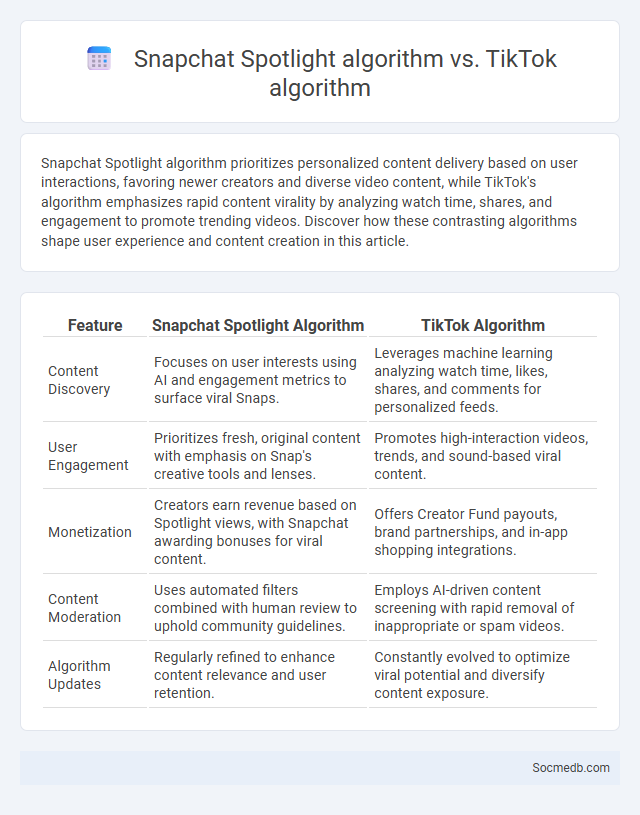
Photo illustration: Snapchat Spotlight algorithm vs TikTok algorithm
Snapchat Spotlight algorithm prioritizes personalized content delivery based on user interactions, favoring newer creators and diverse video content, while TikTok's algorithm emphasizes rapid content virality by analyzing watch time, shares, and engagement to promote trending videos. Discover how these contrasting algorithms shape user experience and content creation in this article.
Table of Comparison
| Feature | Snapchat Spotlight Algorithm | TikTok Algorithm |
|---|---|---|
| Content Discovery | Focuses on user interests using AI and engagement metrics to surface viral Snaps. | Leverages machine learning analyzing watch time, likes, shares, and comments for personalized feeds. |
| User Engagement | Prioritizes fresh, original content with emphasis on Snap's creative tools and lenses. | Promotes high-interaction videos, trends, and sound-based viral content. |
| Monetization | Creators earn revenue based on Spotlight views, with Snapchat awarding bonuses for viral content. | Offers Creator Fund payouts, brand partnerships, and in-app shopping integrations. |
| Content Moderation | Uses automated filters combined with human review to uphold community guidelines. | Employs AI-driven content screening with rapid removal of inappropriate or spam videos. |
| Algorithm Updates | Regularly refined to enhance content relevance and user retention. | Constantly evolved to optimize viral potential and diversify content exposure. |
Introduction to Short-Form Video Algorithms
Short-form video algorithms prioritize user engagement by analyzing watch time, likes, shares, and comments to curate personalized content feeds. Platforms like TikTok, Instagram Reels, and YouTube Shorts utilize machine learning models to detect viewer preferences and trending topics, optimizing video recommendations. This seamless content delivery increases platform retention rates and enhances user experience through dynamic, relevant short-form videos.
What Is Snapchat Spotlight Algorithm?
Snapchat Spotlight Algorithm curates and promotes user-generated short videos based on engagement metrics such as views, shares, and completion rates to maximize content visibility. The algorithm leverages machine learning to analyze user interactions, preferences, and trending topics, tailoring the feed to individual interests. This personalization ensures that high-quality, relevant Spotlight videos reach a broader audience, driving user activity and platform retention.
TikTok Algorithm: Core Features Explained
TikTok's algorithm prioritizes user engagement by analyzing factors such as video interactions, watch time, and content shares to curate a personalized feed tailored to Your preferences. It leverages machine learning to detect trending sounds, hashtags, and challenges, boosting content visibility within relevant communities. Content creators benefit from this system as it amplifies reach through continuous feedback loops based on user behavior and content performance metrics.
Spotlight vs. TikTok: Key Differences
Spotlight and TikTok differ significantly in content discovery and user engagement methods, with TikTok leveraging an AI-driven For You page for personalized video recommendations, while Spotlight emphasizes user privacy by curating popular short videos without extensive data tracking. Both platforms prioritize short-form video content, but TikTok offers a wider array of creative tools and effects, enhancing content creation versatility. Understanding these differences allows you to choose the platform best suited for your social media goals and audience reach.
Content Discovery Mechanisms Compared
Social media platforms utilize diverse content discovery mechanisms such as algorithm-driven feeds, hashtag aggregations, and user-curated recommendations to enhance engagement and personalize user experience. Algorithms on platforms like Instagram and TikTok prioritize content relevance based on user interactions, while Twitter relies heavily on hashtag trends and real-time topic clustering. User-curated mechanisms, exemplified by Pinterest boards, empower personalized content exploration by leveraging community-generated collections and preferences.
User Engagement Strategies: Snapchat vs. TikTok
Snapchat leverages interactive filters, ephemeral content, and personalized streaks to boost user engagement, fostering a sense of immediacy and exclusivity. TikTok capitalizes on its algorithm-driven For You Page, trend-driven challenges, and seamless video editing tools to maximize content virality and user participation. To enhance your social media presence, understanding these distinct strategies can help tailor your approach to either platform effectively.
Creator Monetization: Snapchat Spotlight vs. TikTok
Snapchat Spotlight and TikTok offer distinct creator monetization opportunities through revenue sharing models and audience engagement tools. TikTok provides creators with the Creator Fund, brand partnerships, and live gifting features, while Snapchat Spotlight rewards viral videos with daily payouts based on engagement metrics. To maximize your earnings, understanding each platform's algorithm and actively interacting with your audience are crucial for sustainable growth and monetization.
Popularity Factors in Each Algorithm
Social media algorithms prioritize factors such as user engagement, content relevance, and video completion rates to determine popularity. Your posts gain more visibility when they receive likes, shares, comments, and extended watch time, signaling high value to the platform. Tailoring content to trending topics and audience interests maximizes algorithmic favor and increases your reach.
Algorithm Transparency and User Control
Social media platforms continuously refine their algorithms to personalize content delivery, yet limited algorithm transparency can hinder users' understanding of how their data influences what they see. You have the right to demand greater algorithm transparency and enhanced user control, enabling you to customize your feed, manage data usage, and reduce exposure to biased or manipulative content. Improved transparency and control tools empower users to create safer, more relevant online experiences tailored to their preferences.
The Future of Short-Form Content Algorithms
Short-form content algorithms are evolving to prioritize personalized user engagement through advanced AI-driven recommendations, enhancing content discovery and retention. Platforms like TikTok and Instagram Reels leverage machine learning to analyze user behavior patterns, optimizing feed relevancy and maximizing viewer interaction time. The future development of these algorithms will emphasize real-time data processing and ethical considerations around content diversity and user well-being.
 socmedb.com
socmedb.com